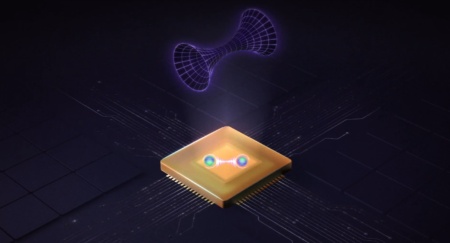
We translated an interesting article from the site quantamagazine.org about the physicists who created the first wormhole in history.
Researchers were able to send a signal through an open wormhole. But not everything is so simple. It seems that physicists managed to create the first ever wormhole – a kind of tunnel described in 1935 by Albert Einstein and Nathan Rosen. This tunnel leads from one place to another with an additional dimension of space.
The wormhole originated as a hologram of quantum bits of information, or “qubits,” stored in tiny superconducting circuits. By manipulating qubits, physicists sent information through a wormhole.
A team led by Maria Spiropoulos of the California Institute of Technology implemented a new wormhole teleportation protocol using Google’s quantum computer, a device called Sycamore, hosted by Google Quantum AI in Santa Barbara, California. With this “quantum gravity experiment on a chip,” Spiropoulou and her team defeated a group of competing physicists seeking to teleport into a wormhole using IBM and Quantinuum quantum computers.
Course
MANAGER OF WORK WITH CLIENTS
Become a sought-after specialist and receive your dream offer.
REGISTER!
The experiment can be seen as proof of the holographic principle, a hypothesis about how the two pillars of fundamental physics, quantum mechanics and general relativity, fit together. Since the 1930s, physicists have tried to reconcile these disjointed theories. One is a rule book for atoms and subatomic particles, the other is Einstein’s description of how matter and energy deform the fabric of space-time, giving rise to gravity.
The holographic principle, which became popular in the 1990s, assumes a mathematical equivalence or duality between two structures. Its proponents argue that the flexible space-time continuum described by general relativity is actually a quantum system of disguised particles. Space-time and gravity arise through quantum effects, just as a 3D hologram projects a 2D template.
Wormholes were first talked about almost a century ago, but it took years of theory development and a “crazy” team of experimenters to create the first one on a quantum computer.
This experiment confirms that quantum effects, which can be controlled in a quantum computer, are capable of creating a phenomenon that we expect to see in the theory of relativity – a wormhole.
But we cannot see it (unlike a regular hologram). Although it can be considered a “fiber of real space-time” (according to co-author Daniel Jafferis of Harvard University, the lead developer of the wormhole teleportation protocol), it is not part of the same reality in which we live and the Sycamore computer. The holographic principle says that two realities—one with a wormhole and one with qubits—are alternate versions of the same physics, but how to conceptualize this duality remains unclear.
The holographic wormhole in the experiment consists of a space-time different from the space-time of our own universe. But does this really prove that the space-time we inhabit is also holographic, enlightened by quantum bits?
“I think that gravity in our universe arises from some quanta. [битов] just as this little one-dimensional wormhole emerges from the Sycamore chip. But this has not yet been proven,” Jafferis said.
Into a wormhole
Holographic wormhole research dates back to two seemingly unrelated papers published in 1935: the first by Einstein and Rosen (ER paper), the second by these two and Boris Podilsky (EPR paper).
In a paper by ER, Einstein and his young assistant Rosen deduced the possibility of wormholes in an attempt to extend the general theory of relativity to the unified theory of everything: descriptions not only of space-time, but also of subatomic particles suspended in it.
They took into account elements in the space-time fabric that German soldier physicist Carl Schwarzschild found among the folds of general relativity in 1916, just months after Einstein published the theory. Schwarzschild showed that mass can be gravitationally attracted so strongly that it becomes infinitely concentrated at a point, distorting space-time so dramatically that the variables become infinite and Einstein’s equations fail.
We now know that these singularities exist throughout the universe. These are points that we can neither describe nor see, each of them hidden in the center of a black hole that gravitationally detains the entire environment. Singularities are where a quantum theory of gravity is most needed.
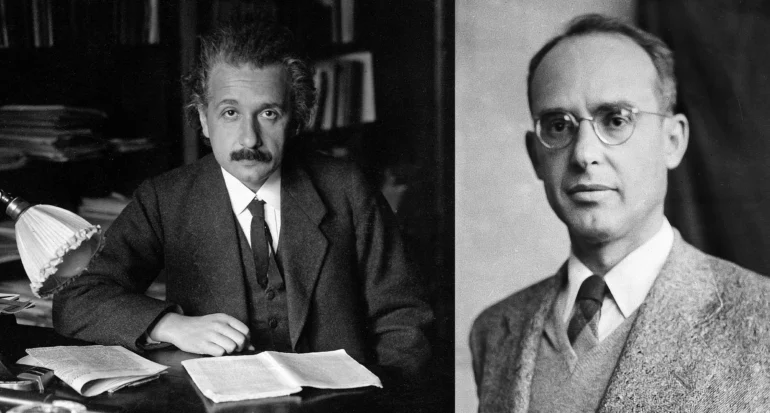
Albert Einstein (left, 1920) and Nathan Rosen (ca. 1955) stumbled upon the possibility of wormholes in a 1935 paper.
Einstein and Rosen suggested that Schwarzschild’s mathematics might be a way to connect the elementary particles of general relativity. To make the picture work, they cut the singularity out of his equations, replacing it with new variables that replaced the sharp point with an excessive pipe sliding into another part of spacetime. Einstein and Rosen mistakenly suggested that these “bridges” (or wormholes) could be particles.
Ironically, in their efforts to connect wormholes and particles, scientists overlooked a strange particle phenomenon they had identified two months before Podolsky in the EPR paper: quantum entanglement.
Entanglement occurs when two particles interact. According to quantum rules, particles can have several possible states at the same time. This means that interactions between particles have several possible outcomes, depending on what state each particle is in. However, their final states will be related. After such an interaction, the particles have a general formula that defines the various combined states in which they can be.
The consequence that made the authors of EPR question quantum theory was the “spooky action at a distance,” as Einstein put it: measuring a particle A (choosing one reality among its possibilities) instantly determines the corresponding state B, no matter how far away B is.
The importance of “entanglement” became clearer after physicists discovered in the 1990s that it enabled new kinds of computation. The entanglement of two qubits (quantum objects such as particles that exist in two possible states, 0 and 1) gives four possible states with different probabilities (0 and 0, 0 and 1, 1 and 0, 1 and 1).
Three qubits create eight simultaneous possibilities, etc.; the power of a “quantum computer” grows exponentially with each additional entangled qubit. Prototypes of quantum computers consisting of several tens of qubits have been created in the last couple of years: this is, for example, the 54-qubit Sycamore machine from Google.
But quantum gravity researchers have focused on quantum entanglement for another reason: as a possible source code for a space-time hologram.
ER = EPR
Talk of emergent spacetime and holography began in the late 1980s, after black hole theorist John Wheeler proposed that spacetime and everything in it could emerge from information. Soon, other researchers, among whom was the Dutch physicist Gerard Hooft, began to speculate whether this appearance could resemble a projection of a hologram.
In a 1994 paper titled “The World as a Hologram,” Leonard Susskind, a quantum gravity theorist at Stanford University, fleshed out Hoft’s holographic principle. He argued that the volume of spacetime described by general relativity is equivalent or double to the system of quantum particles at the lower boundary of the domain.
The example of holography followed in three years. Juan Maldasena, a quantum gravity theorist now at the Institute for Advanced Study in Princeton, New Jersey, discovered that a space called anti-de Sitter space (AdS) is indeed a hologram.
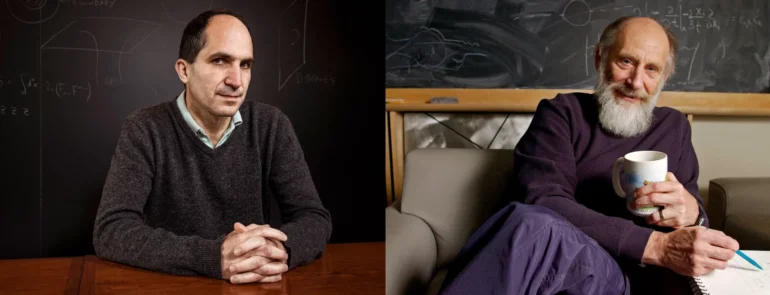
Juan Maldacena (left) and Leonard Susskind are leaders in the holographic approach to quantum gravity. In 2013, they proposed that wormholes in spacetime are equivalent to quantum entanglement. This hypothesis is known as ER = EPR.
The actual universe is de Sitter’s space, a sphere that is constantly growing and expanding due to its own positive energy. In contrast, AdS space is filled with negative energy, the result of the difference in the signs of one constant in the equations of general relativity. It gives space a “hyperbolic” geometry: objects shrink as they move outward from the center of space, becoming infinitesimally small at the outer boundary.
Maldasen showed that the space-time and gravity inside the AdS universe exactly match the properties of a quantum system at the boundary (specifically a system called conformal field theory, or CFT).
Maldasena’s 1997 paper was cited in subsequent studies 22,000 times: an average of more than twice a day. “The best theorists have been trying to use these ideas for several decades,” said Peter Voight, a mathematical physicist at Columbia University.
When Maldasen was exploring his AdS/CFT map between dynamical spacetime and quantum systems, he made a new discovery about the wormhole. He studied a special model of entanglement involving two sets of particles, where each particle in one set is entangled with a particle in the other. Maldasena showed that this state is mathematically dual to a rather dramatic hologram: a pair of black holes in AdS space whose interiors are connected by a wormhole.
It took a decade before Maldasen realized in 2013 that his discovery might imply a more general correspondence between quantum entanglement and wormhole coupling. He wrote the mysterious equation ER=EPR in an e-mail to Susskind, who immediately understood everything. They speculated: “We argue that the Einstein-Rosen bridge between two black holes is created by EPR-like correlations between the microstates of the two black holes,” and that the duality may be more general: “It is very tempting to believe that any correlated EPR system with by some ER bridge”.
Perhaps a wormhole connects every entangled pair of particles in the universe, forming a spatial link that records their shared history. Perhaps Einstein’s assumption that wormholes are associated with particles was correct.
Strong bridge
When Jafferis heard Maldacena’s lecture on ER=EPR at a conference in 2013, he realized that the assumed duality should allow you to create custom wormholes by tailoring the entanglement pattern.
Standard Einstein-Rosen bridges are disappointing for science fiction fans: if they were formed, they would quickly collapse under the influence of their own gravity, and no spacecraft would be able to pass through them. But Jafferis imagined that a wire or something could be strung between the two sets of entangled particles encoding the two wormhole openings.
With such a connection, the action on the particles on one side will cause changes in the particles on the other side, possibly opening a wormhole between them. “Could it be that this makes the wormhole accessible?” asked Jaferis, who had been fascinated by wormholes since childhood (he was a prodigy who had already started studying at Yale University at the age of 14).
Together with his graduate student Ping Gao and researcher Aaron Wall, he calculated that by combining two sets of entangled particles, an operation could be performed on the left set. In the dual space-time picture, it holds open the wormhole leading to the right hole and pushes the qubit through.
The 2016 discovery of this walkable holographic wormhole by Jafferis, Gao, and Wall gave researchers new insights into the mechanics of holography.
A few months later, Maldasena and two colleagues built a circuit, showing that a traversing wormhole could be implemented. “A quantum system that is simple enough that we can imagine creating it,” Jafferis said.
The SYK model is a system of matter particles that interact in groups rather than ordinary pairs. It was first described by Subir Sachdev and Jinwa Yeh in 1993. And in 2015, theoretical physicist Oleksiy Kitaev discovered that it is holographic.
At a lecture that year in Santa Barbara, California, Kitaev enthusiastically presented evidence that a particular version of the model, in which matter particles interact in groups of four, is mathematically mirrored by a one-dimensional black hole in AdS space with the same symmetry and other properties. “Some of the answers are the same in both cases,” he said to the audience. Maldasen sat in the front row.
Connecting the dots, Maldasena and co-authors suggested that the two SYK patterns linked together could encode the two openings of the Jaffreys, Gao, and Wall wormhole. By 2019, the authors had found a specific recipe for teleporting a qubit of information from one system of particles interacting in four directions to another.
The rotation of all directions of rotation of the particles turns into a double space-time picture into a shock wave of negative energy, which sweeps through the wormhole, pushing the qubit forward and, at the right time, exits the hole.
“Jaffries’ red hole is the first concrete implementation of ER = EPR where it shows that the relationship holds exactly for a particular system,” said Alex Zlokapa, a graduate student at MIT and co-author of the new experiment.
A wormhole in the laboratory
While the theoretical work was developing, Maria Spiropoulou, an accomplished experimental particle physicist who was involved in the discovery of the Higgs boson in 2012, was thinking about how to use the new quantum computers to conduct holographic experiments on quantum gravity. In 2018, she convinced Jeffries to join her growing team, along with Google Quantum AI researchers – custodians of the Sycamore device.
To run Jaffreys and Gao’s wormhole teleportation protocol on a quantum computer, Spiropoulos’ team had to simplify the protocol significantly. The full SYK model consists of a virtually infinite number of particles bound together with random force, as four-way interactions occur throughout. This cannot be calculated even using all 50 available qubits.
The researchers decided to create a holographic wormhole using only seven qubits and hundreds of operations. To do this, they had to “thin” the seven-particle SYK model, encoding only the strongest four-way interactions and excluding the others, while preserving the model’s holographic properties. “It took a few years to figure out the best way to do it,” Spiropoulo said.
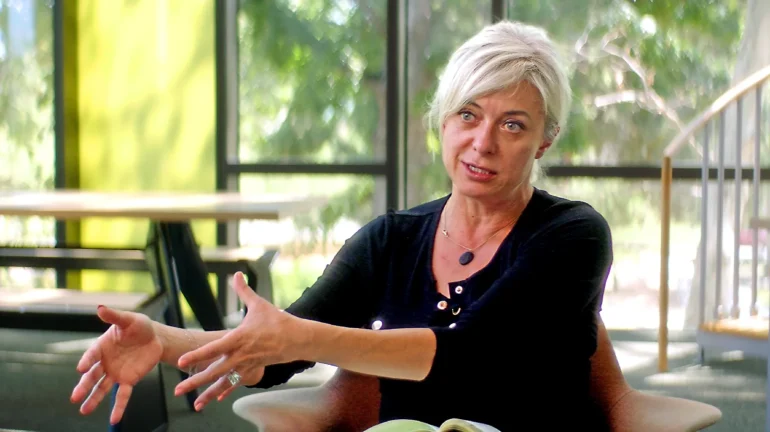
Maria Spiropoulou, a physicist at the California Institute of Technology, led the team that conducted the new wormhole experiment.
The success of the experiment was helped by the talented programmer Zlokapa, who joined Spiropoulos’ research group while still a Caltech student. He reflected the interaction of the SYK model particles on the communication between the neurons of the neural network and trained the system to remove as many network connections as possible while preserving the key signature of the wormhole. The procedure reduced the number of four-way interactions from hundreds to five.
The team then began programming the Sycamore qubits. The seven qubits encode 14 particles of matter—seven in the left and right SYK systems, where each particle on the left is entangled with a particle on the right. Then the eighth qubit by some probabilistic combination of states 0 and 1 changes from one of the particles of the left SYK model.
The possible states of this qubit quickly combine with the states of the other particles to the left, distributing information evenly between them. It is a holographic double qubit entering the left opening of a one-dimensional wormhole in AdS space.
Then there is a large rotation of all the qubits, double the momentum of the negative energy passing through the wormhole. The rotation causes the introduced qubit to go to the particles of the right SYK model. The information then doesn’t propagate, Preskill said, “like chaos running backwards” and refocuses on the location of one particle to the right—the entangled partner of the left particle that was replaced. All qubit states are then measured. Counting 0s and 1s over many experimental runs and comparing these statistics to the prepared state of the injected qubits reveals whether the qubits are teleporting.
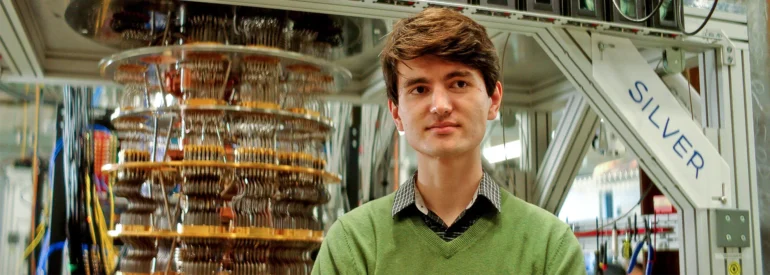
Alex Zlokapa, a graduate student at MIT who joined the wormhole project as an undergraduate, found a way to simplify the wormhole protocol enough to run it on Google’s quantum computer.
The researchers expect a peak: In one case, this means that spins of qubits double the pulses of negative energy allow them to teleport, while spins in the opposite direction, double the pulses of normal positive energy, keep the qubits out, causing the wormhole to close.
Two years of work on the project have passed. Zlokapa was resting after the first semester of graduate studies. One evening, he ran a finished protocol on Sycamore. And the peak appeared on the computer screen.
“It became sharper and sharper,” the researcher recalls. “I sent the screenshots to Maria and wrote that it must be a wormhole.” The peak was the first indication that gravity could be seen on a quantum computer.

The housing of one of several replicas of the Sycamore chip, consisting of 50-plus qubits of superconducting aluminum circuitry.
The meaning of the wormhole
Jafferis believes that this experiment will influence the development of quantum mechanics. Quantum phenomena such as entanglement are usually opaque and abstract; we do not know, for example, how a measurement of a particle A determines the state of B from afar. But in this experiment, the quantum phenomenon – the teleportation of information between particles – has a real interpretation as a particle that receives a jolt of energy and moves with speed from A to B.
Perhaps a quantum process like teleportation “always experiences a gravitational effect on the qubit. If something like this can come out of this experiment and other related experiments, we can learn a lot about our universe.”

Maria Spiropoulou at the California Institute of Technology
Susskind, who reviewed the results, said he hopes future wormhole experiments involving many more qubits can be used to probe the inside of a wormhole as a way to probe the quantum properties of gravity.
Some physicists will say that the experiment says nothing about our universe because it implements a duality between quantum mechanics and anti-de Sitter space, which our universe is not.
For 25 years after Maldasen’s discovery of the AdS/CFT correspondence, physicists have been searching for a similar holographic duality for de Sitter space. But some doubt whether de Sitter space is holographic at all. “Questions like ‘How do we make this work in the more physical case of dS?’ are not new, but very old and have been the subject of tens of thousands of man-years of futile effort,” said Voight, the AdS critic. /CFT study. “Completely different ideas are needed.”
Critics argue that the two types of space are categorically different: AdS has an outer boundary, while dS space does not, so there is no smooth mathematical transition from one to the other. The hard boundary of AdS space is what makes holography easy in such conditions, providing a quantum surface from which space is projected. By comparison, in our de Sitter universe, the only limits are what we can see and the infinite future. These are foggy surfaces from which you can try to project a space-time hologram.
Renate Loll, a renowned quantum gravity theorist at Radboud University in the Netherlands, also emphasized that the wormhole experiment is about 2D spacetime. A wormhole is a thread with one spatial dimension plus a temporal dimension, and gravity in 4D is more complicated. “It’s tempting to get bogged down in the intricacies of 2D toy models and ignore the more serious challenges that await us in 4D quantum gravity. “I don’t understand how quantum computers with their current capabilities can be very useful,” said the researcher.
Most quantum gravity researchers believe that these are all complex but solvable problems—that the scheme that entangles 4D de Sitter space is more complex than that of 2D AdS, but we can nevertheless gain general information by studying holography in simpler conditions These people tend to think that the two types of space, dS and AdS, are more similar than different.
Still, Susskind agrees it’s time to pay attention. “I think now is the time to get out from under the protective layer of AdS space and explore a world that might have more to do with cosmology,” he said.
In September, Susskind suggested that de Sitter space might be a hologram of another version of the SYK model, one that does not contain four-way particle interactions, but one in which the number of particles involved in each interaction grows as the square root of the total number of particles. This “double scale limitation” of the SYK model “behaves more de Sitter-like than AdS,” he said.
Such a quantum system is more complex than what has been programmed so far, and the scientist is not sure whether it will be possible to implement it in the laboratory. But most likely, now that there is one holographic wormhole, we can hope for new discoveries.




